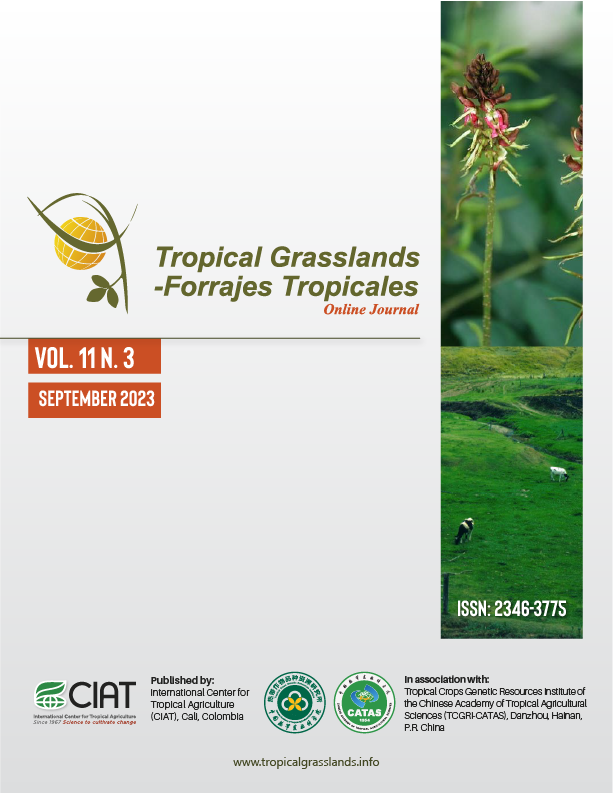Seedling emergence of tropical perennial pasture species in response to temperature used to determine sowing time recommendations
DOI:
https://doi.org/10.17138/tgft(11)198-209Abstract
Tropical pasture grasses and legumes can be highly productive and persistent and fill the summer-autumn feed gap typical of temperate pasture systems in southern Australia. However, more information is needed on optimum temperature range for seedling emergence because this will influence sowing time recommendations. A replicated field experiment was conducted at 5 locations in New South Wales over a 12-month period to determine the optimum temperature for emergence of a range of tropical species: Rhodes grass (Chloris gayana Kunth), Makarikari grass (Panicum coloratum L. var. makarikariense Gooss.), kikuyu grass (Cenchrus clandestinus (Hochst. ex Chiov.) Morrone), digit grass (Digitaria eriantha Steud.), panic grass (Megathyrsus maximus (Jacq.) B.K. Simon & S.W.L. Jacobs), paspalum (Paspalum dilatatum Poir.), Urochloa hybrid (Urochloa decumbens × U. ruziziensis × U. brizantha), 2 cultivars of Desmanthus virgatus (L.) Willd. (cultivars ‘Marc’ and ‘JCU2’), D. bicornutus (S. Watson), D. leptophyllus (Kunth) and D. pernambucanus (L.) Thell.). Rhodes grass emerged satisfactorily over the longest time across all sites, exhibiting the greatest temperature range over which emergence occurred, while Makarikari grass and panic grass had the narrowest temperature range for emergence. The temperature for 50% emergence differed between the tropical species and whether the soils were warming or cooling. Rhodes grass had the lowest 50% emergence temperature (17 °C) while paspalum had the highest (22 °C). Results showed that temperature for 50% emergence is a useful indicator for determining sowing time in warming soils.
References
Akima H; Gebhardt A; Maechler M. 2022. Akima: Interpolation of Irregularly and Regularly Spaced Data. R package version 0.6-3.4. bit.ly/47T73Si
Angus JF; Cunningham RB; Moncur MW; Mackenzie DH. 1980. Phasic development in field crops I. Thermal response in the seedling phase. Field Crops Research 3:365–378. doi: 10.1016/0378-4290(80)90042-8
Boschma SP; Lodge GM; Harden S. 2008. Herbage mass and persistence of pasture legumes and grasses at two potentially different saline and waterlogging sites in northern New South Wales. Australian Journal of Experimental Agriculture 48(4):553–567. doi: 10.1071/EA07115
Boschma SP; Lodge GM; Harden S. 2009. Establishment and persistence of perennial grass and herb cultivars and lines in a recharge area, North-West Slopes, New South Wales. Crop and Pasture Science 60(8):753–767. doi: 10.1071/CP08357
Cook BG; Pengelly BC; Schultze-Kraft R; Taylor M; Burkart S; Cardoso Arango JA; González Guzmán JJ; Cox K; Jones C; Peters M. 2020. Tropical Forages: An interactive selection tool. 2nd and Revised Edn. International Center for Tropical Agriculture (CIAT), Cali, Colombia and International Livestock Research Institute (ILRI), Nairobi, Kenya. tropicalforages.info
Descheemaeker K; Llewellyn R; Moore A; Whitbread A. 2014. Summer-growing perennial grasses are a potential new feed source in the low rainfall environment of southern Australia. Crop and Pasture Science 65(10):493–500. doi: 10.1071/CP13444
Egan MK; Boschma SP; Harden S; Harris CA; Edwards C. 2017. Temperature for seedling emergence of tropical perennial grasses. Crop and Pasture Science 68(5):493–500. doi: 10.1071/CP17139
Gardiner CP. 2016. Developing and commercializing new pasture legumes for clay soils in the semi-arid rangelands of Northern Australia: the new Desmanthus cultivars JCU 1-5 and the Progardes story. In: Lazier JR; Ahmad N; eds. 2016. Tropical forage legumes – harnessing the potential of Desmanthus and other genera for heavy clay soils. CAB International, Wallingford, UK. p. 283–304. doi: 10.1079/9781780646282.0283
Hare MD; Tatsapong P; Saipraset K. 2007. Seed production of two brachiaria hybrid cultivars in north-east Thailand. 1. Method and time of planting. Tropical Grasslands 41(1):26–34. bit.ly/45s7Rfg
Harris CA; Boschma SP; Murphy SR; McCormick LH, eds. 2014. Tropical perennial grasses for northern inland NSW. Second Edition. Future Farm Industries Cooperative Research Centre, Perth, Australia. bit.ly/3qTDWxE
Isbell RF; National Committee on Soil and Terrain, eds. 2021. The Australian Soil Classification. Third edition. CSIRO Publishing, Melbourne, Australia. 192 p. bit.ly/3sA8Mf4
Jones RM. 1969. Mortality of some tropical grasses and legumes following frosting in the first winter after sowing. Tropical Grasslands 3(1):57–63. bit.ly/45tG7qA
Lodge GM; Harden S. 2009. Effects of depth and time of sowing and over-wintering on tropical perennial grass seedling emergence in northern New South Wales. Crop and Pasture Science 60(10):954–962. doi: 10.1071/CP09088
Lodge GM; Brennan MA; Harden S. 2010. Field studies of the effects of pre-sowing weed control and time of sowing on tropical perennial grass establishment, North-West Slopes, New South Wales. Crop and Pasture Science 61(2):182–191. doi: 10.1071/CP09227
McDonald W; Bowman A. 2002. Successful establishment of tropical perennial grasses in North West NSW. Agnote DPI-156 NSW Department of Primary Industries. bit.ly/3Z6te3A
Moore GA; Barrett-Lennard P. 2006. Subtropical grasses. In: Moore GA; Sandford P; Wiley T, eds. 2006. Perennial pastures for Western Australia. Department of Agriculture and Food, WA Bulletin 4690. p. 129–134. bit.ly/45QLuzR
Moore GA; Sanford P; Dolling PJ; Real D. 2021. The challenges of developing resilient perennial pastures for a Mediterranean environment – a review for Western Australia. Crop and Pasture Science 72(9):613–633. doi: 10.1071/CP20304
Morris B. 2009. Variation and Breeding of Kikuyu Grass (Pennisetum clandestinum). Ph.D. Thesis. University of Sydney, Sydney, Australia. hdl.handle.net/2123/8961
Moser LE; Burson BL; Sollenberger LE, eds. 2004. Warm-season (C4) grasses. American Society of Agronomy, Madison, USA. doi: 10.2134/agronmonogr45.c1
Nichols PGH; Yates RJ; Loo C; Wintle BJ; Titterington JW; Barrett-Lennard EG; Stevens JC; Dixon KW; Moore GA. 2012. Establishment of sub-tropical perennial grasses in south-western Australia. Future Farm Industries CRC Technical Report 9, First Edition. bit.ly/3sC1rMb
Nie ZN; Miller S; Moore GA; Hackney BF; Boschma SP; Reed KFM; Mitchell M; Albertsen TO; Clark S; Craig AD; Kearney G; Li GD; Dear BS. 2008. Field evaluation of perennial grasses and herbs in southern Australia. 2. Persistence, root characteristics and summer activity. Australian Journal of Experimental Agriculture 48(4):424–435. doi: 10.1071/EA07136
Pizarro EA; Hare MD; Mutimura M; Changjun Bai. 2013. Brachiaria hybrids: potential, forage use and seed yield. Tropical Grasslands–Forrajes Tropicales 1(1):31−35. doi: 10.17138/tgft(1)31-35
Quirk M; McIvor J. 2006. Grazing land management Technical Manual. Meat and Livestock Australia, Sydney, Australia. bit.ly/3LEk0Wu
R Core Team. 2020. R: A language and environment for statistical computing. R Foundation for Statistical Computing, Vienna, Austria. www.R-project.org
Reed KFM. 2014. Perennial pasture grasses-An historical review of their introduction, use and development for southern Australia. Crop and Pasture Science 65(8):691–712. doi: 10.1071/CP13284
Unger PW. 1978. Straw mulch effects on soil temperatures and sorghum germination and growth. Agronomy Journal 70(5):858–864. doi: 10.2134/agronj1978.00021962007000050036x
Ward LD. 1993. The establishment of warm-season perennial grasses on degraded Vertisols in North-West New South Wales. Master of Rural Science Thesis. University of New England, Armidale, Australia.
Watt LA; Whalley RDB. 1982. Establishment of small-seeded perennial grasses on black clay soils in north-western New South Wales. Australian Journal of Botany 30(6):611–623. doi: 10.1071/BT9820611
How to Cite
Downloads
Downloads
Published
Issue
Section
License
Copyright (c) 2023 Tropical Grasslands-Forrajes Tropicales

This work is licensed under a Creative Commons Attribution 4.0 International License.




